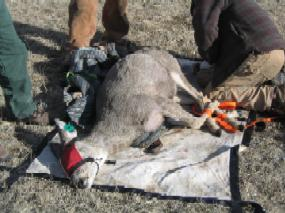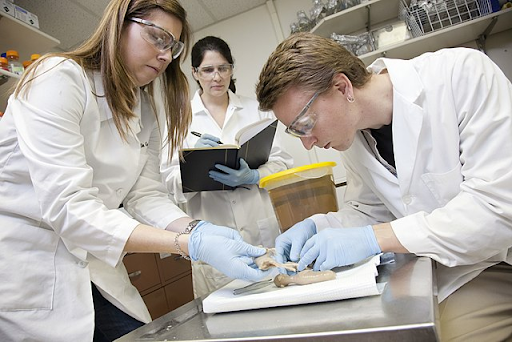Imagine a cross between rabies and a zombie virus that slowly incapacitates its prey. This may sound like something out of a B-Rated Sci-Fi flick, but Chronic Wasting Disease, or CWD, is a very real phenomenon.
No, infected deer don’t go around biting each other. Rather, CWD spreads either through indirect contact, like urine, blood, saliva, or feces; or direct contact between infected cervids (mammals in the deer family). But what is CWD?
Chronic Wasting Disease is a neurodegenerative disease that occurs due to misfolded prions. Prions are misfolded proteins, which are problematic since this misfolding can make the protein lose its structure and function. The misfolded prions serve as a basis for the folding of other prions, which lead to more and more misfolded prions. The result of this is none other than the deadly “zombie” disease.
“The functions of these normal prion proteins are still not completely understood. The abnormal folding of the prion proteins leads to brain damage and the characteristic signs and symptoms of the disease. Prion diseases are usually rapidly progressive and always fatal,” said Dr. Khaled Mahmoud, a Biology Research, Genetics, and Microbiology teacher at Bronx Science.
Infected animals exhibit unusual behavior, including lack of coordination and loss of fear of humans. In addition, they show physical symptoms, such as excessive salivation, immense thirst, severe weight loss, dull eyes, and abscesses or lumps near the spinal cord and tonsils.
The disease has been around for several decades, but it’s only come to mainstream attention in recent years. In the 1960s, a Colorado research facility discovered a mysterious ailment afflicting captive deer. Since then, Chronic Wasting Disease has spread across America — particularly the central United States.
Although it’s colloquially known as “zombie deer disease,” CWD doesn’t only affect deer. It also affects deer-adjacent members of the Cervidae, like moose and elk, since they are genetically similar.
CWD is relevant because it is the most contagious among prion diseases in the environment. Other prion diseases include Mad-Cow disease, and Creutzfeldt-Jakob disease in humans. The prevalence of CWD is estimated to be in 50% of free-ranging deer and over 90% in captive herds.

Based on a 2022 report, current news articles have been recounting how two hunters died after eating deer meat from populations known to have CWD. While this information is concerning and disheartening, there is not enough conclusive evidence to suggest CWD is capable of being transmitted in humans.
In one study, approximately 200 people were exposed to CWD after consuming infected deer meat at a gathering in New York in 2005. This group was monitored for six years and researchers found no significant changes in their health conditions. This suggests that if there is a risk to humans of obtaining CWD through consuming infected meat, it is quite low. However, with the long incubation period of prion diseases, we can not definitively say CWD can be spread through consumption without more concrete studies.
There is evidence that non-cervid animals, like cats and coyotes, can contract CWD – and there are currently no vaccines or treatments. CWD prions can remain contagious in the environment, through soil and plant uptake, even after the infected animal dies. For this reason, other animals (and not just scavengers) in proximity to the CWD infested areas are likely to develop Chronic Wasting Disease.
CWD Infection Timeline
Infection: The cervid becomes infected through contact with CWD contaminants such as blood, urine, saliva, etc.
Final Few Weeks to Months: Distinct symptoms such as excessive salivation and increased drinking occur. At this stage, the infected animals typically have a few weeks to several months left to live.
Year 2-3 Onwards: There are some early symptoms, including weight loss and changes in behavior, but these symptoms are difficult to spot and are not only attributed to CWD.
Final Few Weeks to Months: Distinct symptoms like excessive salivation and increased drinking occur. The infected animals have around a few weeks to several months to live
Terminal Stage: The condition of the infected cervid rapidly deteriorates, leading to emaciation. Videos on platforms like YouTube graphically depict cervids in this final stage, showing deer falling over, foaming at the mouth, chewing nothing, and convulsing.
As a whole, this timeline is generally 18-24 months long from infection to death.
CWD Detection and Prevention
In the past, diagnosing CWD involved complex medical procedures, such as brain/spinal cord tissue examination. This was usually done after the deer’s death to see if the caught deer had CWD. This post-mortem testing can take up to two weeks and can’t be done at home. Each state has their own state labs that conduct testing, with some states in the CWD zones offering free testing. These results do not declare the deer safe to eat, but rather only their CWD status.

Recent research has unveiled a promising avenue for universal early detection of Chronic Wasting Disease through a simple and noninvasive approach: analyzing fecal samples. After examining the gut microbiome of both CWD-positive and negative deer, scientists identified specific bacterial signatures associated with the disease.
When deer are exposed to CWD, their digestive tract is altered, causing certain bacteria levels to fluctuate. This creates a unique profile that serves as a marker.
Several researchers from Germany and the United States collaborated on a research journal detailing their findings. “Our results show promising trends suggesting that fecal microbial composition can directly correspond to CWD disease status. These results point to the microbial composition of the feces as a potential tool for diagnostics and surveillance of CWD in the wild, including non-invasive CWD detection in asymptomatic deer and deer habitats, and enable conceptual advances in our understanding of the disease.”
Wildlife managers and conservationists can now collect fecal samples from deer populations to evaluate the number of infected cervids in the area without disturbing the animals. These samples provide valuable information about CWD prevalence in specific regions and keep our maps of CWD spread updated. By monitoring the gut microbiome, scientists and researchers alike hope to detect CWD at an earlier stage, expediting the efforts to reduce the rate of CWD spread.
This is beneficial – but how can the general population help prevent the spread of CWD?
In several states, including Texas, Wisconsin, and Michigan, testing for Chronic Wasting Disease in your game is free. Results are usually found online and released in around two weeks. Testing is mandated in the areas where CWD is commonly found. The hunters (using gloves and other proper protective equipment) need to bring their catch to a nearby testing station within 48 hours of their initial harvest.
After hunting, it’s important to keep deer within the CWD zone. Symptoms of CWD may take a while to manifest, so deer that appear asymptomatic are not necessarily in the clear. Deer hunters should avoid handling brain, spinal cord, and organ tissue, as well as get their game tested. If the deer is infected, hunters need to take necessary precautions to prevent further spread.
In New York State, bringing in carcasses of hunter-killed deer, elk, moose, or caribou is illegal. This is because there’s a risk that these animals, despite being dead, could be infected with CWD, potentially leading to an outbreak.
The Centers for Disease Control and Prevention (CDC) advises hunters against shooting, eating, or touching meat that could be infected. These precautions are necessary due to the potential dangers associated with consuming venison from infected cervids, as highlighted by the mysterious deaths of two hunters in 2022. Furthermore, any tools that have come into contact with CWD-infected meat should be thoroughly bleached to eliminate the prions.
Through collaboration among microbiologists, ecologists, wildlife experts, and individuals like you, we can move closer to discovering methods to cure our local deer populations and prevent the spread of CWD.
Through the collaboration between microbiologists, ecologists, wildlife experts, and you, we can take a step closer to unveiling the ways to cure our local deer and prevent the spread of CWD.
CWD is relevant because it is the most contagious among prion diseases in the environment. Other prion diseases include Mad-Cow disease, and Creutzfeldt-Jakob disease in humans. The prevalence of CWD is estimated to be in 50% of free-ranging deer and over 90% in captive herds.

